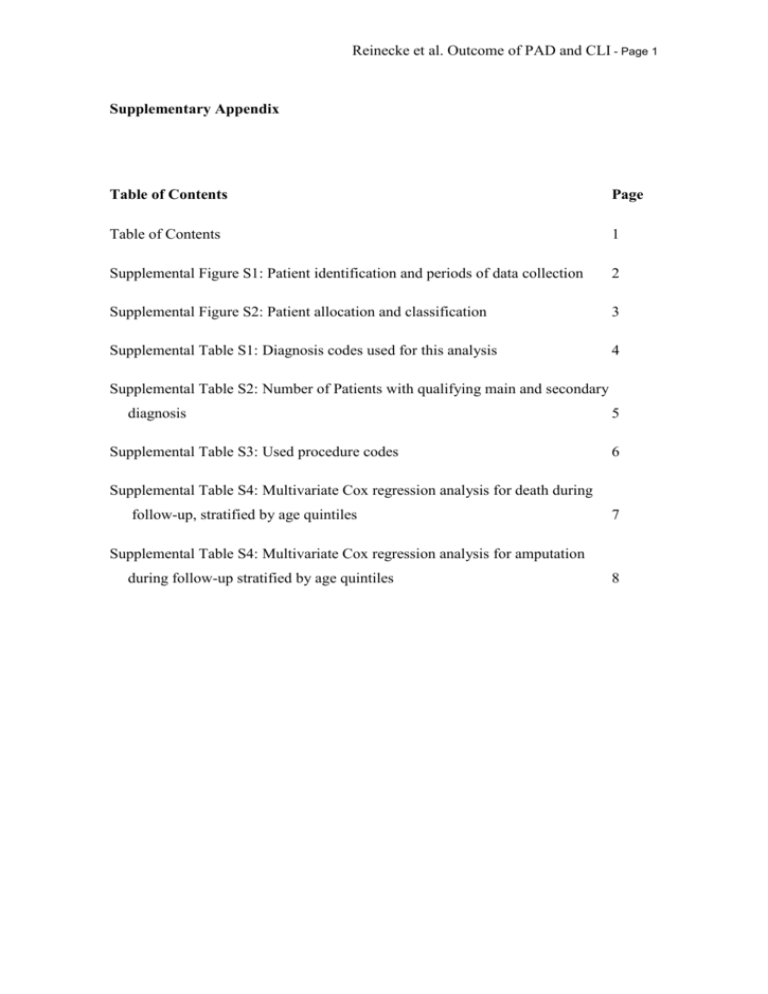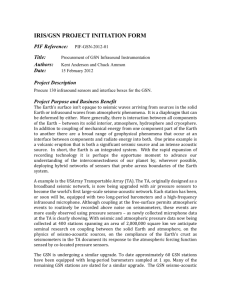Emergency coronary artery bypass grafting for failed coronary
advertisement

Reinecke et al. Outcome of PAD and CLI - Page 1 Supplementary Appendix Table of Contents Page Table of Contents 1 Supplemental Figure S1: Patient identification and periods of data collection 2 Supplemental Figure S2: Patient allocation and classification 3 Supplemental Table S1: Diagnosis codes used for this analysis 4 Supplemental Table S2: Number of Patients with qualifying main and secondary diagnosis Supplemental Table S3: Used procedure codes 5 6 Supplemental Table S4: Multivariate Cox regression analysis for death during follow-up, stratified by age quintiles 7 Supplemental Table S4: Multivariate Cox regression analysis for amputation during follow-up stratified by age quintiles 8 Reinecke et al. Outcome of PAD and CLI - Page 2 Supplemental Figure S1: Patient identification and periods of data collection Total pool of about 8 million insured patients Hospital admission between Jan 1st, 2009 and Dec 31st, 2011 AND Any hospitalization with qualifiying main diagnosis code (see Methods and Supplementary Table S1 and Figure S2) 60,221 patients identified Exclusion of patients without confirmed co-existing PAD 41,882 patients included Diagnosis and procedural data collection Jan 1st, 2009 Dec 31st, 2011 Index-hospitalization during Jan 1st, 2009 and Dec 31st, 2011 Dec 31st, 2012 24 months before hospitalization Follow-up until Dec 31st, 2012 data collection during the 24 months before index hospitalization collection of follow-up data until Dec 31st, 2012 Supplemental Figure S2: Patient allocation and classification into Rutherford subgroups 60,221 patients identified Main diagnosis of lower limb PAD (ICD-10: I70.20-I70.24) Secondary diagnosis of lower limb PAD (ICD-10: I70.20-I70.24) 33,339 patients identified plus 8,543 patients identified = 41,882 patients included Main or secondary diagnosis of Rutherford category 6 (ICD-10: I70.24) 18,339 patients not inlcuded Main or secondary diagnosis of Rutherford category 5 (ICD-10: I70.23) Main or secondary diagnosis of Rutherford category 4 (ICD-10: I70.22) Main or secondary diagnosis of Rutherford category 1-3 (ICD-10: I70.20 or I70.21) 8,416 patients with Rutherford 6 6,916 patients with Rutherford 5 5,353 patients with Rutherford 4 21,197 patients in Rutherford 1-3 From the 60,221 patients who qualified for analysis due to a hospital admission during the mentioned period (Supplemental Figure S1), a total of 33,339 patients had a main diagnosis of PAD and were included in the analysis. Another 8,543 patients had a related main diagnosis (Supplemental Table S1) in combination with a secondary diagnosis of lower limb PAD and were also included. These 41,882 patients were than classified by their main or secondary diagnosis in a top-down approach in subgroups with Rutherford 6, 5, 4 or 1-3. Reinecke et al. Outcome of PAD and CLI - Page 4 Supplemental Table S1: Diagnosis codes used for this analysis according to ICD-10 (German modification) ICD code Codes for qualifying diagnoses E10.50, E10.51 E10.74, E10.75 E11.50, E11.51 E11.72, E11.73 E11.74, E11.75 I70.2* I70.20 I70.21 I70.22 I70.23 I70.24 I70.25 I73* I74* L03.01, L03.02, L03.11 L98.4 R02 Codes for secondary diagnoses A30-49* B95-B99* C* E10* E11* E66* E78* F17* I10-15* I21* I25* I50* I63* I70.2* N17* N18* Description Type I diabetes with peripheral vascular complications Type I diabetes with diabetic foot syndrome Type II diabetes with peripheral vascular complications Type II diabetes with multiple including vascular complications Type II diabetes with diabetic foot syndrome Atherosclerosis of arteries of extremities Lower- limb: Walking distance 200 m and more Lower limb: Exercise induced pain with walking distance < 200 m Lower limb: rest pain Lower limb: ulcerations Lower limb: necrosis and gangrene Upper limb PAD, all stages Other peripheral vascular diseases Arterial embolism and thrombosis Cellulitis of finger and toe including acute lymphangitis Chronic ulcer of skin, not elsewhere classified Gangrene, not elsewhere classified Other bacterial diseases including systemic inflammatory response syndrome Bacterial, viral and other infectious agents Neoplasms Type I diabetes Type II diabetes Obesity Disorders of lipoprotein metabolism and other lipidaemias Mental and behavioural disorders due to use of tobacco Hypertensive disease Acute myocardial infarction Chronic ischaemic heart disease Chronic heart failure Cerebral infarction incl. occlusion and stenosis of cerebral and precerebral arteries, resulting in cerebral infarction Atherosclerosis of arteries of extremities Acute renal failure Chronic kidney disease Diagnosis codes used for patients’ identification and inclusion in the analysis are printed in the upper half of the table. Codes for analysis of secondary diagnoses, comorbidities and complications during in-hospital stay are shown in the lower part of the Table. Of note, the German ICD-10 catalogue is in all cases identical with the WHO ICD-10 catalogue, but provides at some points more detailed subdiagnoses and descriptions for correct coding with the German DRG system. The * indicates that additional digits for specific descriptions of types and locations must be added. ICD-10 indicates International classification of Disease 10th version; PAD, peripheral arterial disease. Supplemental Table S2: Number of Patients with qualifying main and secondary diagnosis with regard to their ICD-10 codes Main diagnosis Secondary diagnosis of PAD (ICD-10 I70.2*) None I70.20 I70.21 I70.22 Total, n I70.23 I70.24 9 4 E10.50 8 2 6 3 E10.51 5 0 3 1 1 E10.74 103 5 1 1 E10.75 119 2 1 E11.50 156 21 E11.51 97 E11.72 I70.25 0 32 6 0 16 35 30 0 175 1 33 35 0 191 710 168 258 276 8 1,597 3 36 22 36 68 1 263 336 15 38 8 30 58 1 486 E11.73 3,261 95 138 43 52 42 1 3,632 E11.74 1,579 91 101 66 1,057 1,438 3 4,335 E11.75 1,068 48 50 29 446 652 2 2,295 I70.20 571 30 17 11 2 2 0 633 I70.21 15,919 128 2,140 95 26 19 18 18,345 I70.22 3,439 26 187 585 37 32 2 4,308 I70.23 3,431 30 113 45 1,025 126 4 4,774 I70.24 3,426 34 86 46 120 1,561 6 5,279 I70.25 166 6 19 1 4 4 23 223 I73.0 412 7 8 2 2 3 4 438 I73.1 91 2 9 4 4 7 0 117 I73.8 98 1 3 1 2 0 1 106 I73.9 227 9 13 4 4 7 0 264 I74.0 148 6 68 35 9 10 0 276 I74.1 30 0 1 2 1 0 0 34 I742 756 12 27 6 2 2 17 822 I74.3 1,858 84 494 502 110 185 1 3234 I74.4 51 2 4 7 3 3 0 70 I74.5 134 8 62 53 6 19 2 284 I74.8 55 1 0 0 0 0 0 56 I74.9 31 3 3 5 1 1 0 44 L03.01 1,654 1 1 1 0 1 3 1,661 L03.02 747 22 12 5 25 14 0 825 L03.11 4,014 42 45 31 49 70 0 4,251 740 18 5 6 22 7 0 798 328 9 1 1 2 16 0 357 45,058 763 4,402 1,790 3,413 4,698 97 60,221 L98.4 R02 Total, n Patients were included in the analysis (bold cells and numbers) if they either had a main diagnosis of lower limb PAD (I70.20 to I70.24) OR if they had one of the other main diagnoses on the left in combination with a secondary diagnosis of lower limb PAD. ICD-10, International classification of Disease 10th version; PAD, peripheral arterial disease. Supplemental Table S3: Used procedure codes in accordance to the OPS classification OPS Code Description 3-605 Diagnostic angiography of iliac vessels 3-607 Diagnostic angiography of lower limb vessels 8-836* Endovascular treatment (e.g. PTA, thrombolysis) 8-84* Endovascular stenting 5-380* Incision, embolectomy and thrombectomy 5-381* Thrombendatherectomy 5-383* Resection and interponats of blood vessels 5-386* Excision of aneurysms 5-388* Suture of vascular vessels 5-393* Peripheral bypass grafting 5-395* Patch operations 5-864* Major amputations, above the ankle 5-865* Minor amputations, below the ankle 5-866* Revision of an amputation All procedures and interventions have to be coded with a distinct code for type and anatomic location of the treatment, which then is relevant for correct grouping and reimbursement in the German DRG system. The * indicates that additional digits for specific descriptions of types and anatomic locations can/must be added. OPS indicates “Operationen und Prozedurenschlüssel”. Reinecke et al. Outcome of PAD and CLI - Page 7 Supplemental Table S4: Multivariate Cox regression analyses for death during follow-up, stratified by age quintiles Age 0-61 years (n=8,504) HR (95% CI) p Age 62-69 years (n=8,796) HR (95% CI) p 1 Age 70-75 years Age 76-82 years Age 83-99 years (n=8,836) (n=8,022) (n=7,723) HR (95% CI) p 1 HR (95% CI) p 1 HR (95% CI) p RF 1-3 1 1 RF 4 2.00 (1.59-2.51) <0.001 2.00 (1.67-2.37) <0.001 1.94 (1.66-2.26) <0.001 1.96 (1.72-2.24) <0.001 2.06 (1.83-2.32) <0.001 RF 5 3.31 (2.66-4.11) <0.001 2.73 (2.34-3.17) <0.001 2.52 (2.21-2.87) <0.001 2.58 (2.31-2.89) <0.001 2.29 (2.07-2.54) <0.001 RF 6 3.87 (3.20-4.67) <0.001 3.60 (3.13-4.13) <0.001 3.44 (3.06-3.87) <0.001 4.02 (3.62-4.46) <0.001 3.55 (3.22-3.91) <0.001 Male gender 1.24 (1.05-1.46) 0.01 1.23 (1.09-1.38) 0.001 1.25 (1.13-1.38) <0.001 1.22 (1.13-1.32) <0.001 1.14 (1.07-1.22) <0.001 Hypertension 1.11 (0.95-1.29) 0.2 0.83 (0.74-0.93) 0.001 0.85 (0.77-0.94) 0.001 0.75 (0.69-0.82) <0.001 0.84 (0.79-0.89) <0.001 Obesity 0.93 (0.74-1.16) 0.5 0.85 (0.71-1.02) 0.08 0.92 (0.78-1.08) 0.3 0.80 (0.68-0.95) 0.011 0.74 (0.60-0.92) 0.006 Dyslipidemia 0.73 (0.61-0.87) <0.001 0.72 (0.64-0.81) <0.001 0.73 (0.65-0.81) <0.001 0.80 (0.73-0.88) <0.001 0.68 (0.62-0.74) <0.001 Smoking 0.93 (0.77-1.11) 0.4 1.08 (0.93-1.25) 0.3 1.17 (0.98-1.40) 0.8 1.10 (0.90-1.34) 0.4 0.79 (0.61-1.04) 0.09 Diabetes 1.02 (0.87-1.21) 0.8 1.04 (0.93-1.17) 0.5 1.09 (0.99-1.20) 0.8 1.03 (0.95-1.11) 0.5 1.00 (0.93-1.07) 0.9 CAD 1.43 (1.20-1.70) <0.001 1.42 (1.26-1.60) <0.001 1.24 (1.12-1.37) <0.001 1.19 (1.09-1.30) <0.001 1.17 (1.09-1.26) <0.001 CHF 1.93 (1.63-2.34) <0.001 2.03 (1.75-2.35) <0.001 1.66 (1.47-1.87) <0.001 1.68 (1.52-1.85) <0.001 1.48 (1.38-1.60) <0.001 CKD 1.95 (1.63-2.34) <0.001 1.69 (1.50-1.91) <0.001 1.75 (1.59-1.93) <0.001 1.61 (1.48-1.74) <0.001 1.23 (1.15-1.31) <0.001 Malignancies 5.26 (3.77-7.34) <0.001 4.26 (3.39-5.36) <0.001 2.43 (1.98-2.98) <0.001 1.76 (1.44-2.15) <0.001 1.53 (1.27-1.84) <0.001 CAD indicates coronary artery disease; CHF, chronic heart failure, CKD, chronic kidney disease; CI, confidence interval; HR, hazard ratio; MI, myocardial infarction; RF, Rutherford category. Bold numbers indicate significant p-values. Comorbidities were defined on the basis of given ICD-10 codes, and are presented in detail in Supplemental Table S1. Supplemental Table S5: Multivariate Cox regression analyses for amputation during follow-up, stratified by age quintiles Age 0-61 years (n=8,500) HR (95% CI) p Age 62-69 years (n=8,793) HR (95% CI) p 1 Age 70-75 years Age 76-82 years Age 83-99 years (n=8,832) (n=8,017) (n=7,718) HR (95% CI) p 1 HR (95% CI) p 1 HR (95% CI) p RF 1-3 1 1 RF 4 3.13 (2.37-4.13) <0.001 3.36 (2.60-4.35) <0.001 2.70 (2.08-3.49) <0.001 3.30 (2.54-4.27) <0.001 2.15 (1.64-2.82) <0.001 RF 5 12.2 (9.82-15.2) <0.001 11.0 (9.03-13.49) <0.001 9.80 (8.15-11.8) <0.001 8.50 (6.91-10.5) <0.001 4.67 (3.75-5.83) <0.001 RF 6 34.0 (28.0-41.2) <0.001 32.7 (27.3-39.2) <0.001 28.6 (24.1-33.9) <0.001 25.4 (20.9-30.9) <0.001 17.5 (14.3-21.6) <0.001 Male gender 1.27 (1.11-1.45) <0.001 1.38 (1.22-1.56) <0.001 1.37 (1.23-1.52) <0.001 1.37 (1.24-1.52) <0.001 1.28 (1.16-1.40) <0.001 Hypertension 0.96 (0.85-1.09) 0.5 0.98 (0.87-1.10) 0.7 0.96 (0.86-1.07) 0.5 0.93 (0.84-1.04) 0.2 0.84 (0.77-0.93) <0.001 Obesity 0.90 (0.76-1.06) 0.2 0.92 (0.78-1.08) 0.3 0.94 (0.79-1.12) 0.5 0.89 (0.72 1.10) 0.3 0.88 (0.66-1.17) 0.4 Dyslipidemia 0.88 (0.76-1.02) 0.09 0.81 (0.71-0.91) <0.001 0.81 (0.72-0.91) <0.001 0.86 (0.77-0.97) 0.016 0.86 (0.76-0.98) 0.02 Smoking 0.84 (0.71-0.98) 0.026 1.00 (0.84-1.18) 1.0 0.76 (0.61-0.96) 0.02 0.90 (0.67-1.21) 0.5 0.61 (0.39 0.96) 0.032 Diabetes 1.74 (1.54-1.98) <0.001 1.65 (1.48-1.85) <0.001 1.54 (1.39-1.71) <0.001 1.40 (1.27-1.55) <0.001 1.22 (1.11-1.34) <0.001 CAD 1.06 (0.91-1.25) 0.4 0.98 (0.86-1.11) 0.7 1.03 (0.92-1.15) 0.6 0.89 (0.79-0.99) 0.039 1.05 (0.94-1.16) 0.4 CHF 1.17 (0.94-1.46) 0.2 1.10 (0.94-1.29) 0.2 1.08 (0.94-1.24) 0.3 1.22 (1.07-1.39) 0.002 1.02 (0.91-1.14) 0.7 CKD 1.17 (1.01-1.35) 0.036 1.29 (1.14-1.46) <0.001 1.08 (0.97-1.20) 0.2 1.15 (1.04-1.28) 0.009 1.03 (0.93-1.13) 0.5 Malignancies 0.98 (0.61-1.59) 0.9 0.98 (0.69-1.39) 0.9 1.05 (0.79-1.40) 0.7 0.88 (0.64-1.21) 0.4 0.73 (0.52-1.02) 0.07 CAD indicates coronary artery disease; CHF, chronic heart failure, CKD, chronic kidney disease; CI, confidence interval; HR, hazard ratio; MI, myocardial infarction; RF, Rutherford category. Bold numbers indicate significant p-values. Comorbidities were defined on the basis of given ICD-10 codes, and are presented in detail in Supplemental Table S1.







